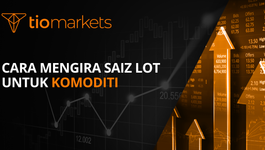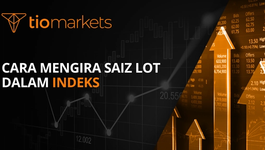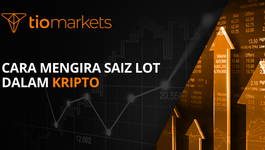Velocity of Money: Definition & Calculation | TIOmarkets
BY TIOmarkets
|Jun 13, 2024The concept of the velocity of money is pivotal in understanding the dynamics of an economy. It offers insights into the rate at which money circulates within the economy, influencing inflation, interest rates, and overall economic health. This article delves into the definition, importance, and methods of calculating the velocity of money, providing a comprehensive overview for traders and investors alike.
Understanding the Velocity of Money
The velocity of money is a measure of the frequency at which one unit of currency is used to purchase domestically-produced goods and services within a given time period. It is an indicator of the economy's efficiency in using its monetary base.
Definition and Importance
The velocity of money is crucial for economists and policymakers as it helps in assessing the health of an economy. A higher velocity indicates a more active and robust economy, where money changes hands frequently, leading to higher spending and investment levels. Conversely, a lower velocity suggests a sluggish economy with less spending and investment.
Factors Influencing Velocity
Several factors can affect the velocity of money, including inflation rates, interest rates, and the overall economic environment. For instance, in times of high inflation, people tend to spend their money more quickly, leading to a higher velocity. Similarly, lower interest rates can encourage borrowing and spending, thereby increasing the velocity of money.
Calculating the Velocity of Money
Understanding how to calculate the velocity of money is essential for analyzing economic trends and making informed decisions.
Formula and Components
The velocity of money is calculated by dividing the Gross Domestic Product (GDP) by the money supply. The formula is represented as V = GDP/M, where V stands for velocity, GDP is the total value of all goods and services produced over a specific time period, and M represents the money supply.
Example of Calculation
For example, if a country's GDP is $2 trillion and its money supply is $500 billion, the velocity of money would be 4. This means that, on average, each unit of currency was used four times to purchase domestically-produced goods and services within the specified time period.
The Significance of Velocity in the Economy
The velocity of money plays a significant role in the functioning of an economy, impacting inflation, interest rates, and overall economic activity.
Influence on Inflation
A higher velocity of money can lead to increased spending, which, if not matched by a corresponding increase in the production of goods and services, can result in inflation. Therefore, understanding the velocity of money can help policymakers and economists predict inflationary trends.
Impact on Interest Rates
Interest rates and the velocity of money are interconnected. Central banks may adjust interest rates to influence the velocity of money, aiming to control inflation and stabilize the economy. For example, raising interest rates can reduce the velocity of money by discouraging borrowing and spending.
Velocity of Money in Monetary Policy
Monetary policy heavily relies on the concept of the velocity of money to achieve economic stability and growth.
Role in Monetary Policy
The velocity of money is a key consideration in the formulation of monetary policy. Central banks monitor changes in the velocity of money to make informed decisions about interest rate adjustments, money supply changes, and other monetary policy tools.
Challenges in Measurement
While the velocity of money is a valuable economic indicator, measuring it accurately can be challenging due to fluctuations in the money supply and GDP. Additionally, the increasing use of digital currencies and payment methods can complicate the calculation of the velocity of money.
Impact on Economic Growth
One crucial aspect of the velocity of money is its impact on economic growth. A higher velocity can stimulate economic activity by encouraging spending and investment, leading to increased production and job creation. On the other hand, a stagnant or declining velocity may signal economic stagnation or recession.
Velocity of Money and Consumer Behavior
Consumer behavior plays a significant role in determining the velocity of money. Factors such as consumer confidence, income levels, and saving habits can influence how quickly money circulates in the economy.
Consumer Confidence
High consumer confidence often leads to increased spending, as individuals are more willing to invest in goods and services. This heightened spending can boost the velocity of money, indicating a healthy and vibrant economy.
Income Levels
The level of income individuals have directly impacts their spending patterns. Higher income earners may have a higher propensity to spend, thereby increasing the velocity of money. Conversely, lower income levels can lead to slower circulation of money within the economy.
Saving Habits
Consumer saving habits can also affect the velocity of money. Individuals who save a significant portion of their income reduce the velocity of money, as less money is being actively used for transactions. In contrast, individuals with lower saving rates contribute to a higher velocity of money.
Technological Advancements and the Velocity of Money
Technological advancements have revolutionized the way money moves within the economy, impacting the velocity of money in various ways.
Digital Payments
The rise of digital payment methods, such as mobile wallets and online banking, has accelerated the speed at which transactions occur. This increased efficiency in transactions can lead to a higher velocity of money, as money changes hands more rapidly in the digital realm.
Cryptocurrencies
The emergence of cryptocurrencies has introduced a new dimension to the velocity of money. Cryptocurrencies enable borderless and near-instantaneous transactions, potentially increasing the velocity of money on a global scale. However, the volatility and regulatory uncertainties surrounding cryptocurrencies can also impact their velocity within the economy.
Conclusion
The velocity of money is a fundamental concept in economics that provides valuable insights into the efficiency and health of an economy. By understanding and calculating the velocity of money, traders, investors, and policymakers can gain a deeper understanding of economic trends and make more informed decisions. Despite its challenges, the velocity of money remains a crucial indicator of economic activity and monetary policy effectiveness.
Start Trading with TIOmarkets Today
Now that you understand the importance of the velocity of money in the economy, take your trading to the next level with TIOmarkets. As a top rated forex broker, we provide you with the tools to trade over 300 instruments across 5 markets, all with low fees. Join our community of 170,000+ traders in over 170 countries and enhance your trading skills with our comprehensive educational resources. Ready to dive into the world of trading? Create a Trading Account with TIOmarkets and start your journey today!

Risk disclaimer: CFDs are complex instruments and come with a high risk of losing money rapidly due to leverage. You should consider whether you understand how CFDs work and whether you can afford to take the high risk of losing your money. Never deposit more than you are prepared to lose. Professional client’s losses can exceed their deposit. Please see our risk warning policy and seek independent professional advice if you do not fully understand. This information is not directed or intended for distribution to or use by residents of certain countries/jurisdictions including, but not limited to, USA & OFAC. The Company holds the right to alter the aforementioned list of countries at its own discretion.
Join us on social media

Behind every blog post lies the combined experience of the people working at TIOmarkets. We are a team of dedicated industry professionals and financial markets enthusiasts committed to providing you with trading education and financial markets commentary. Our goal is to help empower you with the knowledge you need to trade in the markets effectively.





